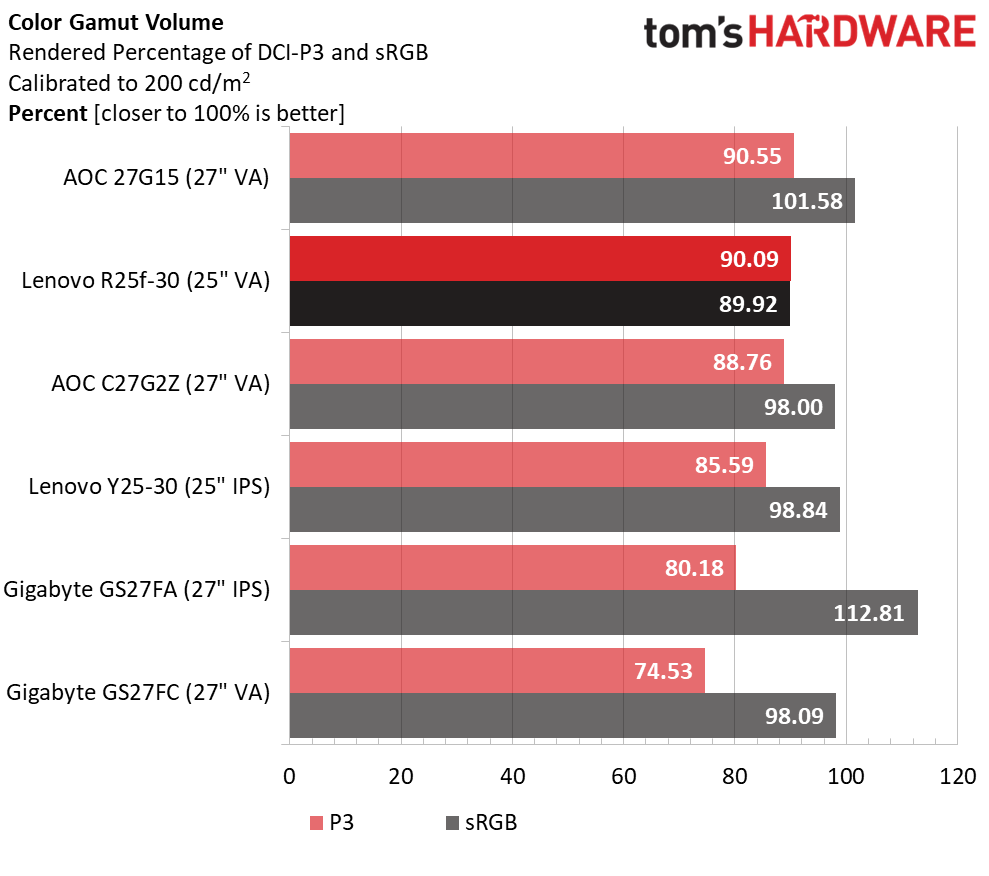Why you can trust Tom's Hardware
The R25f-30 delivers decent color accuracy in its Standard mode. You can use it without changing the color temperature, but it benefits from a gamma tweak, which I’ll talk about now.
Grayscale and Gamma Tracking
Our grayscale and gamma tests use Calman calibration software from Portrait Displays. We describe our grayscale and gamma tests in detail here.



The R25f-30’s default grayscale runs a bit warm with a slight brown tint. It would be great for watching old movies if you like the sepia tone. The error level is just at the point of visibility from 60% to 100% brightness. The greater issue is gamma which is clearly too light. This washes out the image and robs it of liveliness.
Changing the gamma offset to +0.2 makes a world of difference. You could do that and see an improvement but going further with RGB adjustments takes care of any color tint you might see. Calibrated grayscale is in the reference zone with excellent gamma tracking.
If you need sRGB color, that option is available in the color temp menu, but it is not adjustable. Its grayscale tracking is warm in tone with an obviously light gamma. As you’ll see later, its color is under-saturated as well.
Comparisons




The R25f-30’s 3.42dE grayscale error is just over the visible threshold. It isn’t too obvious, but correcting it will make a positive impact. The final 0.83dE score is one of the better results for monitors costing less than $200. Gamma tracking shows a similar result and ranking with a 0.14 range of values and an average of 2.26, 2.73% off the 2.2 standard. Dark gamma is well suited to VA panels thanks to their high native contrast.
Color Gamut Accuracy
Our color gamut and volume testing use Portrait Displays’ Calman software. For details on our color gamut testing and volume calculations, click here.
Get Tom's Hardware's best news and in-depth reviews, straight to your inbox.



The R25f-30 has excellent out-of-box gamut accuracy and significant coverage of DCI-P3. This is another impressive point when considering its low price. You won’t find much better color than this without spending more than $200. The default chart shows near-perfect red compliance with some hue errors in cyan and magenta. Blue is also a little under-saturated.
Calibration fixes these issues and adds a bit of overall saturation thanks to the change in gamma. Only green comes up a tad short, but that’s a typical result for wide gamut displays. It certainly doesn’t get better than this for under $200.
The sRGB result is disappointing. Red and blue are under-saturated, and magenta is off hue. There are no calibration options here, so you get what you see. If you really need an accurate sRGB mode, there are better choices than the R25f-30.
Comparisons


With a final color score of 1.53dE, the R25f-30 ranks among the best. This is pro-level performance which is only approached by the C27G2Z in second place. The R25f-30 also has very high coverage of the DCI-P3 gamut at over 90%. It’s a couple of points ahead of the next screen and only a hair behind the 27G15. Further down the chart, you can see more typical gamut volume performance for this price point. The R25f-30 truly excels.
Test Takeaway: The R25f-30 delivers far better color accuracy and volume than one would expect for $162. It isn’t begging for calibration, but a few tweaks will have a positive impact on picture quality. The default gamma is a bit light, but that’s an easy fix. For the money, it doesn’t get much better than this.
MORE: Best Gaming Monitors
MORE: How We Test PC Monitors
MORE: How to Buy a PC Monitor
MORE: How to Choose the Best HDR Monitor
Current page: Grayscale, Gamma and Color
Prev Page Brightness and Contrast Next Page HDR Performance
Christian Eberle is a Contributing Editor for Tom's Hardware US. He's a veteran reviewer of A/V equipment, specializing in monitors. Christian began his obsession with tech when he built his first PC in 1991, a 286 running DOS 3.0 at a blazing 12MHz. In 2006, he undertook training from the Imaging Science Foundation in video calibration and testing and thus started a passion for precise imaging that persists to this day. He is also a professional musician with a degree from the New England Conservatory as a classical bassoonist which he used to good effect as a performer with the West Point Army Band from 1987 to 2013. He enjoys watching movies and listening to high-end audio in his custom-built home theater and can be seen riding trails near his home on a race-ready ICE VTX recumbent trike. Christian enjoys the endless summer in Florida where he lives with his wife and Chihuahua and plays with orchestras around the state.
